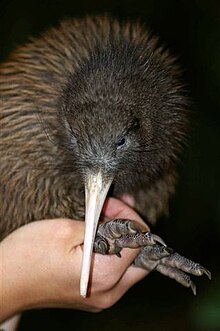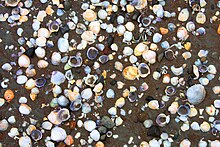
The animals of New Zealand, part of its biota, have an unusual history because, before the arrival of humans, less than 900 years ago, the country was mostly free of mammals, except those that could swim there (seals, sea lions, and, off-shore, whales and dolphins) or fly there (bats). However, as recently as the Miocene, it was home to the terrestrial Saint Bathans mammal, implying that mammals had been present since the island had broken away from other landmasses. The absence of mammals meant that all of the ecological niches occupied by mammals elsewhere were occupied instead by either insects or birds, leading to an unusually large number of flightless birds, including the kiwi, the weka, the moa (now extinct), the takahē, and the kākāpō.


Because of the lack of predators, even bats spend most of their time on the ground. There are also about 60 species of lizard (30 each of gecko and skink), four species of frog (all rare and endangered), and the tuatara (reptiles resembling lizards but with a distinct lineage).
Some butterflies of New Zealand are endemic, while many species have been introduced and some species of butterflies periodically migrate to New Zealand. The Australian painted lady has been known to migrate from Australia to New Zealand in times of strong migration in Australia.
Invasive species
Humans first arrived via the Pacific islands, in several waves at some time before 1300 AD, bringing with them the Polynesian rat (kiore) and the domesticated dog. Europeans later brought pigs, ferrets, stoats, mice, rats, dogs, cats, sheep, cattle, and many other mammals. Of these, the rats, ferrets, cats, stoats and dogs have all seriously impacted the New Zealand fauna, driving some species to extinction. Brushtail possums were introduced from Australia for a fur industry, and deer from Europe as game animals, both seriously damaging the forest habitat of many birds.
In recent years, successful efforts have been made to remove possums, rats, ferrets, and other mammals from many large and small offshore islands in an effort to return these places to something more closely resembling their pre-human state. An estimated 30 tons of dead possums were removed from Kapiti Island, for example. Similarly, efforts are being made to control such species in selected locations on the mainland. In a further step, in certain mainland reserves mammals are being eliminated within predator-proof fences creating ecological islands. Examples are Zealandia in Wellington city, from which about a ton of dead possums was removed after the installation of a mammal-proof fence, and the Maungatautari Restoration Project.
See also
| Part of a series on |
| Biota of New Zealand |
|---|
 |
| BiodiversityFlora and Fauna |
| ConservationProtected areas |
| OrganisationsNational International |
| Associated lawsNew Zealand environmental law |
| Related topics |
- Fauna
- Birds of New Zealand
- Butterflies of New Zealand
- Crabs of New Zealand
- Frogs of New Zealand
- Geckos of New Zealand
- Mammals of New Zealand
- Non-marine and marine molluscs of New Zealand
- Reptiles of New Zealand
- Spiders of New Zealand
- Stick insects of New Zealand
- Other
- Animal welfare in New Zealand
- Biodiversity of New Zealand
- Invasive species in New Zealand
- Flora of New Zealand
References
- Dingle, Hugh; Zalucki, Myron P.; Rochester, Wayne A. (1999). "Season-specific directional movement in migratory Australian Butterflies". Australian Journal of Entomology. 38 (4): 323–329. doi:10.1046/j.1440-6055.1999.00117.x.
- "Rat remains help date New Zealand's colonisation". New Scientist. 4 June 2008. Accessed 2008-06-23
- T. T. Veblen and G. H. Stewart (1982). "The effects of introduced wild animals on New Zealand forests". Annals of the Association of American Geographers, Vol. 72, No. 3, pp. 372 397.
Further reading
- King, Carolyn M.; Barrett, Priscilla (2005). The Handbook of New Zealand Mammals. Oxford University Press. ISBN 9780195584776.
External links
- Native animals at the Department of Conservation
- Fauna of New Zealand Archived 2012-05-11 at the Wayback Machine at Landcare Research
- Animals databases Archived 2012-05-27 at the Wayback Machine at Landcare Research
| Fauna of Oceania | |
|---|---|
| Sovereign states | |
| Associated states of New Zealand | |
| Dependencies and other territories | |